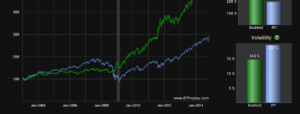In Part 1 we made it clear that the Donald is right about the horrific results of US trade since the 1970s, and that the Keynesian “free traders” of both the saltwater (Harvard) and freshwater (Chicago) schools of monetary central planning have their heads buried far deeper in the sand than does even the orange comb-over with his bombastic affection for 17th century mercantilism.
The fact is, you do not get an $810 billion trade deficit and a 66% ratio of exports ($1.55 trillion) to imports ($2.36 trillion), as the US did in 2017, on a level playing field. And most especially, an honest free market would never generate an unbroken and deepening string of trade deficits over the last 43 years running, which cumulate to the staggering sum of $15 trillion.
Better than anything else, those baleful trade numbers explain why industrial America has been hollowed-out and off-shored, and why vast stretches of Flyover America have been left to flounder in economic malaise and decline.
But two things are absolutely clear about the “why” of this $15 trillion calamity. To wit, it was not caused by some mysterious loss of capitalist enterprise and energy on America’s main street economy since 1975. Nor was it caused—contrary to the Donald’s simple-minded blather—by bad trade deals and stupid people at the USTR and Commerce Department.
After all, American capitalism produced modest trade surpluses every year between 1895 and 1975. Yet it has not lost its mojo during the 43 years of massive trade deficits since then. In fact, the explosion of technological advance in Silicon Valley and on-line business enterprise from coast-to-coast suggests more nearly the opposite.
Likewise, the basic framework of global commerce and trade deals under the WTO and other multi-lateral arrangements was established in the immediate post-war years and was well embedded when the US ran trade surpluses in the 1950s and 1960s.
Those healthy post-war US trade surpluses, in fact, were consistent with the historical scheme of things during the golden era of industrial growth between 1870 and 1914. During that era of gold standard-based global commerce, Great Britain, France, and the US (after the mid-1890s) tended to run trade surpluses owing to their advanced technology, industry and productivity, while exporting capital to less developed economies around the world. That’s also what the US did during the halcyon economic times of the 1950s and 1960s.
What changed dramatically after 1975, however, is the monetary regime, and with it the regulator of both central bank policy and the resulting expansion rate of global credit.
In a word, Tricky Dick’s ash-canning of the Bretton Woods gold exchange standard removed the essential flywheel that kept global trade balanced and sustainable. Thus, without a disciplinary mechanism independent of and external to the central banks, trade and current account imbalances among countries never needed to be “settled” via gains and losses in the reserve asset (gold or gold-linked dollars).
Stated differently, the destruction of Bretton Woods allowed domestic monetary policies to escape the financial discipline that automatically resulted from reserve asset movements. That is, trade deficits caused the loss of gold, domestic deflation and an eventual rebalancing of trade. At the same time, the prolonged accumulation of reserve assets owing to persistent current account surpluses generated the opposite—- domestic credit expansion, price and wage inflation and an eventual reduction in those surpluses.













Leave A Comment